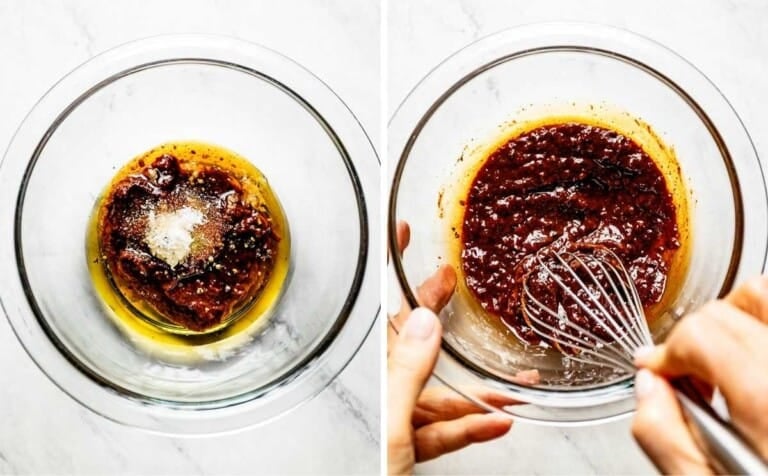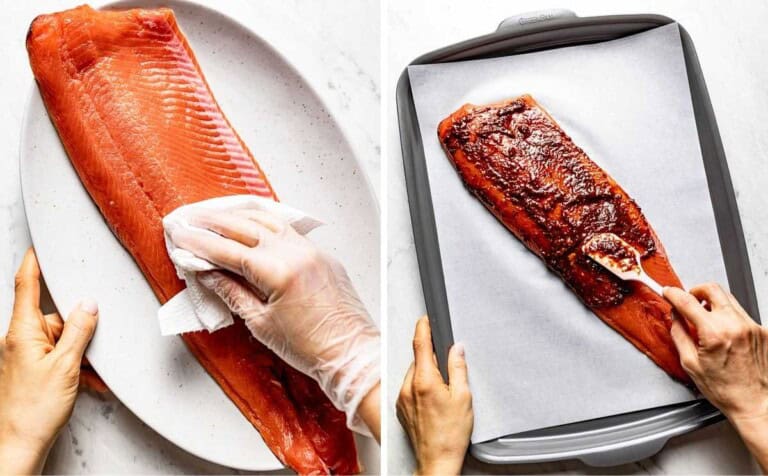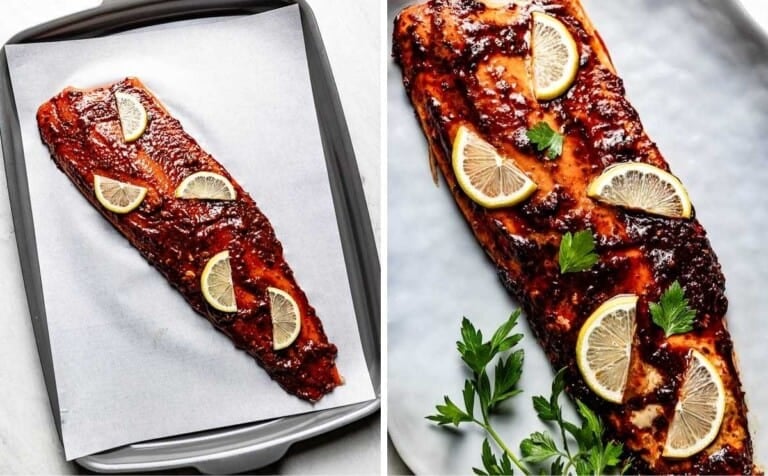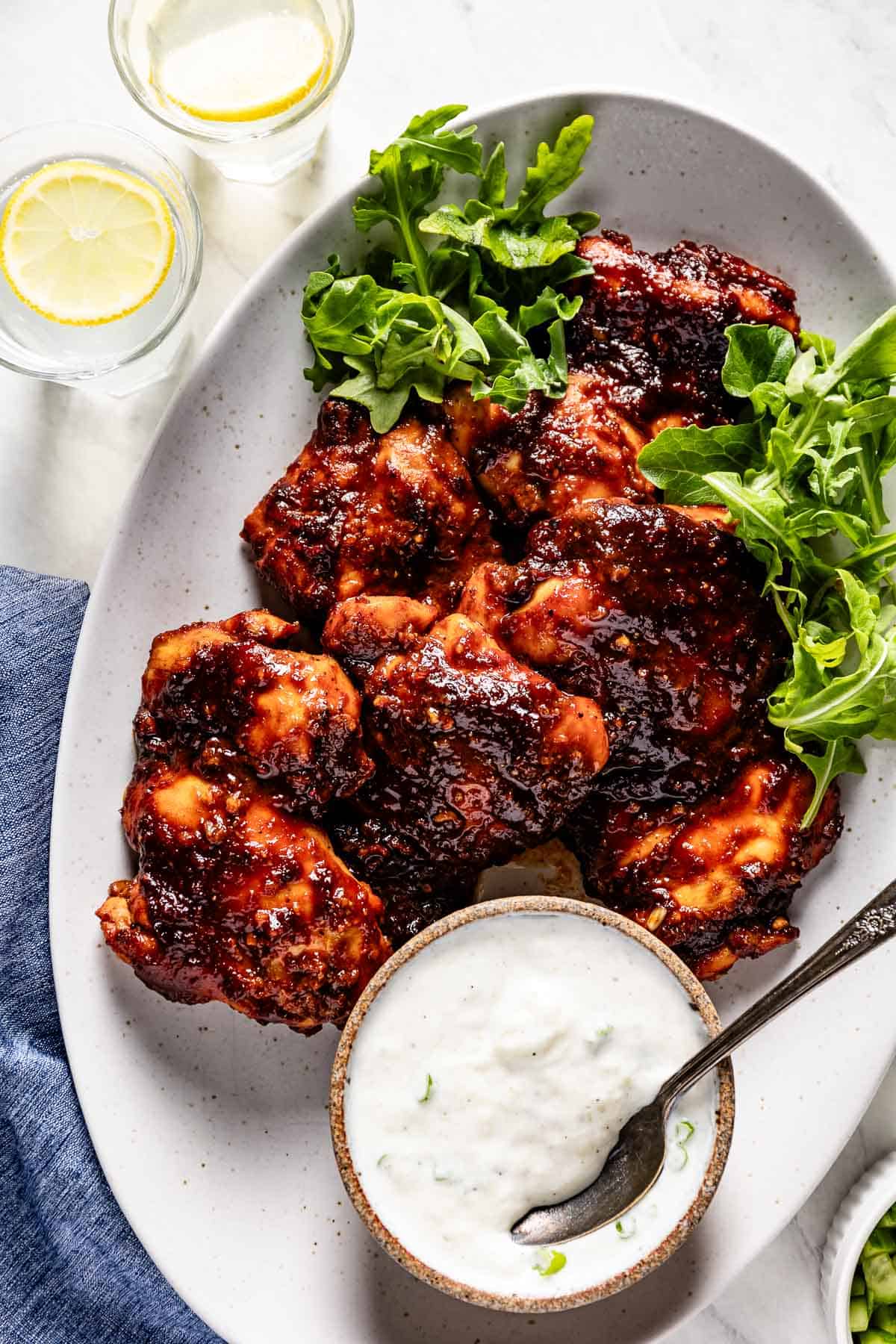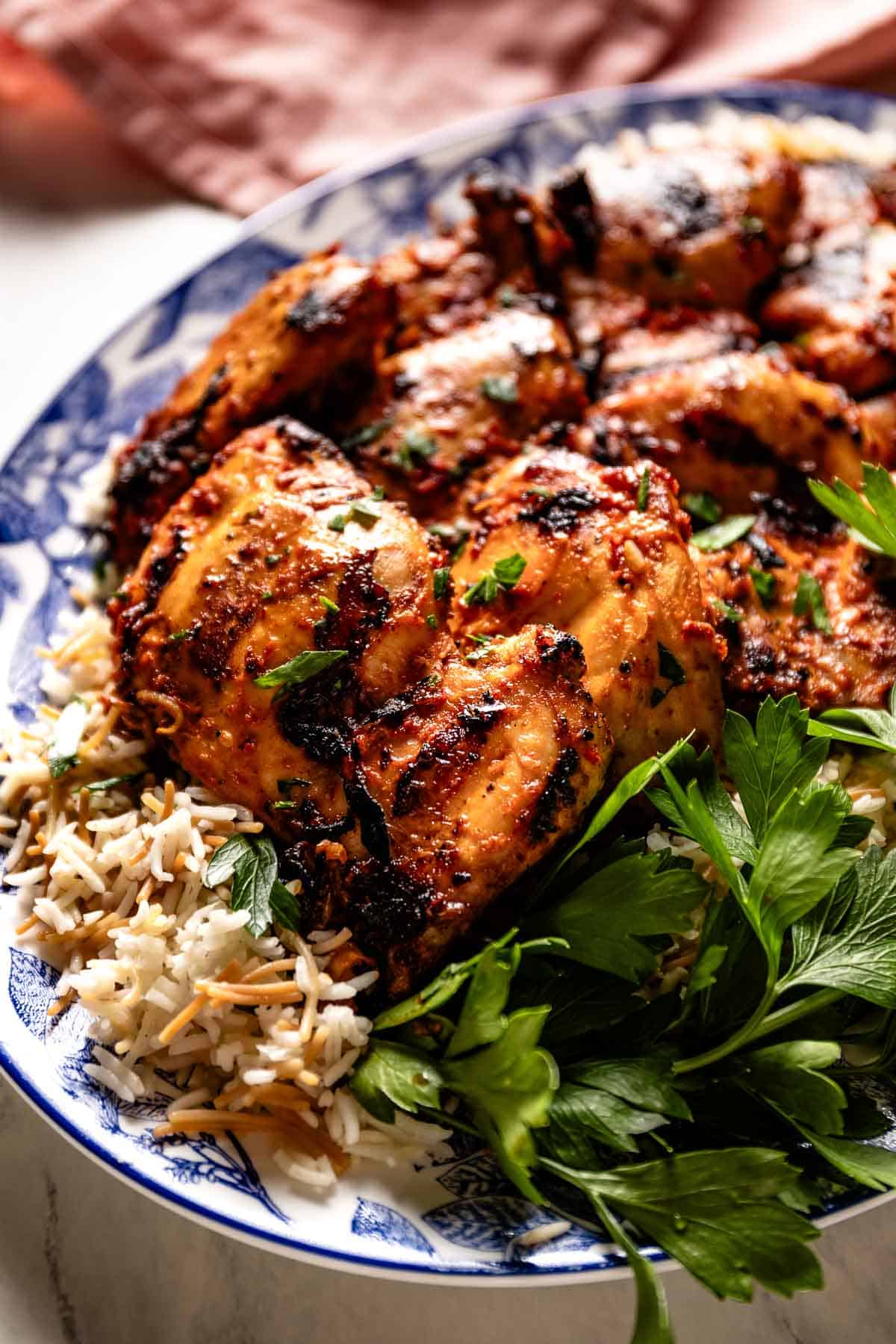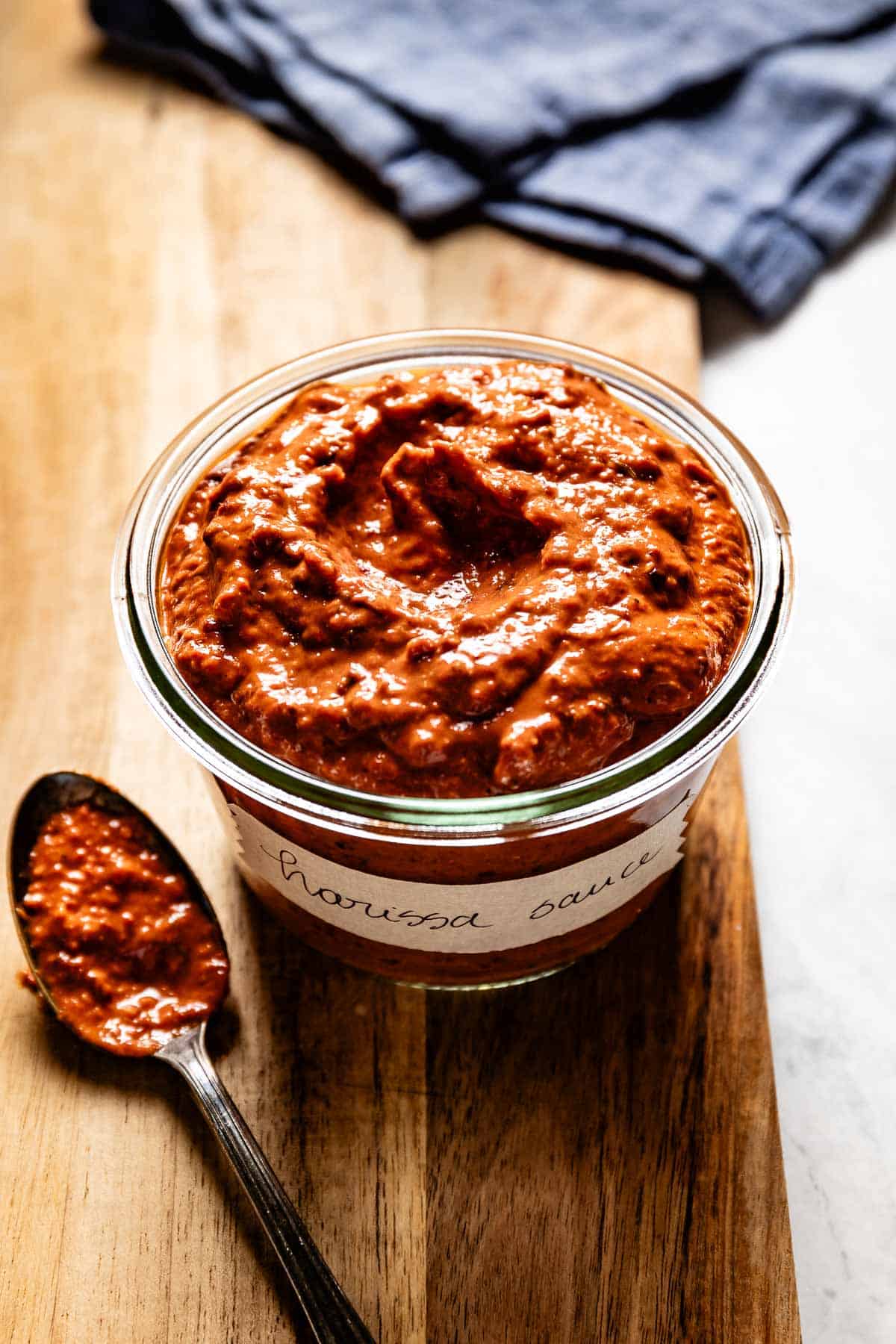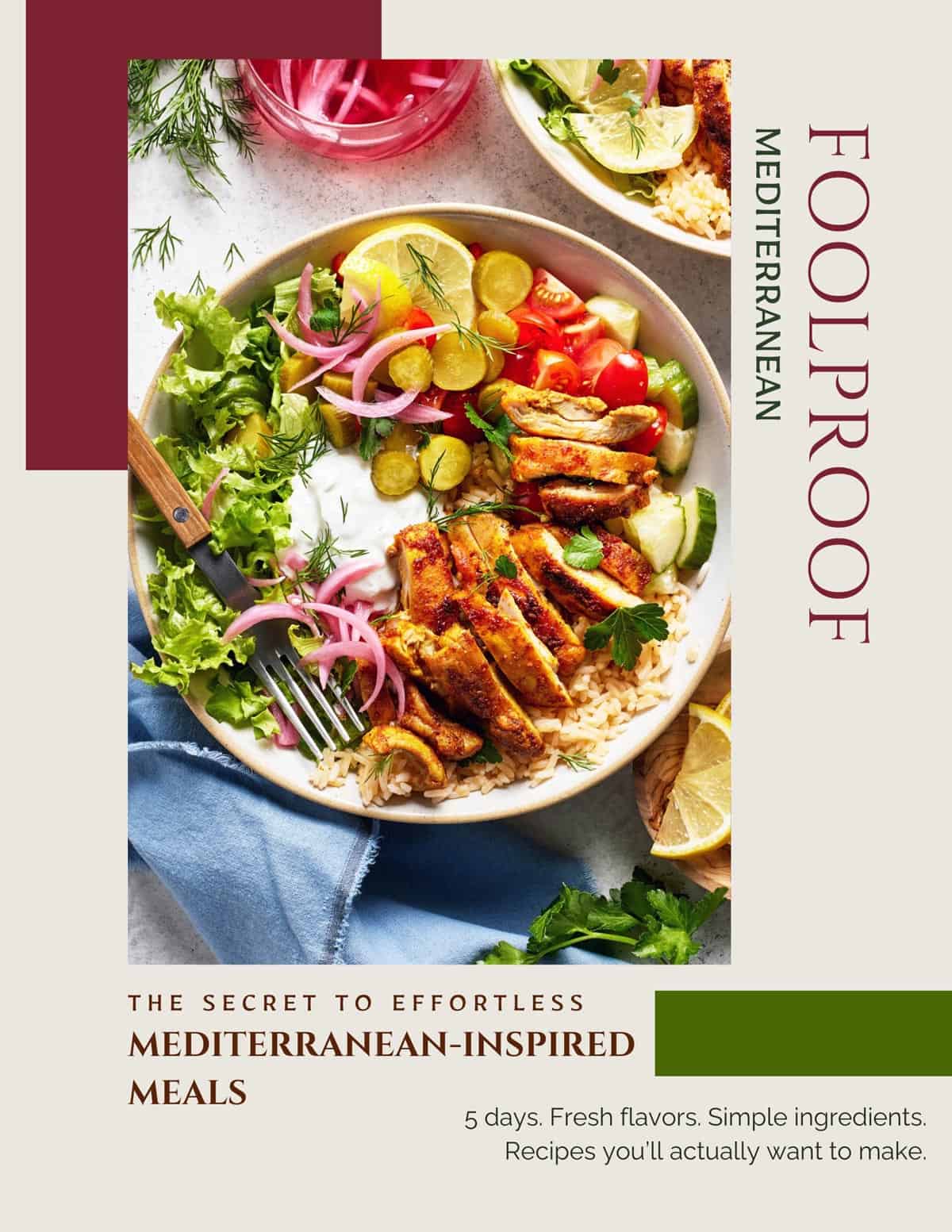My love for Sockeye Salmon started after a trip to Copper River in Alaska, where I had the chance to see how local fishers catch salmon during the short but intense fishing season.
Ever since then, as soon as the Sockeye season starts, I begin thinking about how to make the most of it. This recipe is one of my favorite ways. It combines my love for harissa with the fatty richness of the salmon. Not to mention, it is a fantastic Mediterranean weeknight dinner.
Plus, it’s incredibly easy to prepare. Just mix the glaze, spread it on, and roast. It’s the kind of dish that feels a little fancy but fits perfectly into a busy weeknight.
Ingredients You’ll Need
You do not need a long list of ingredients to make this honey harissa salmon, and while you might have a few of them on hand, harissa is the one you may need to pick up or make from scratch.
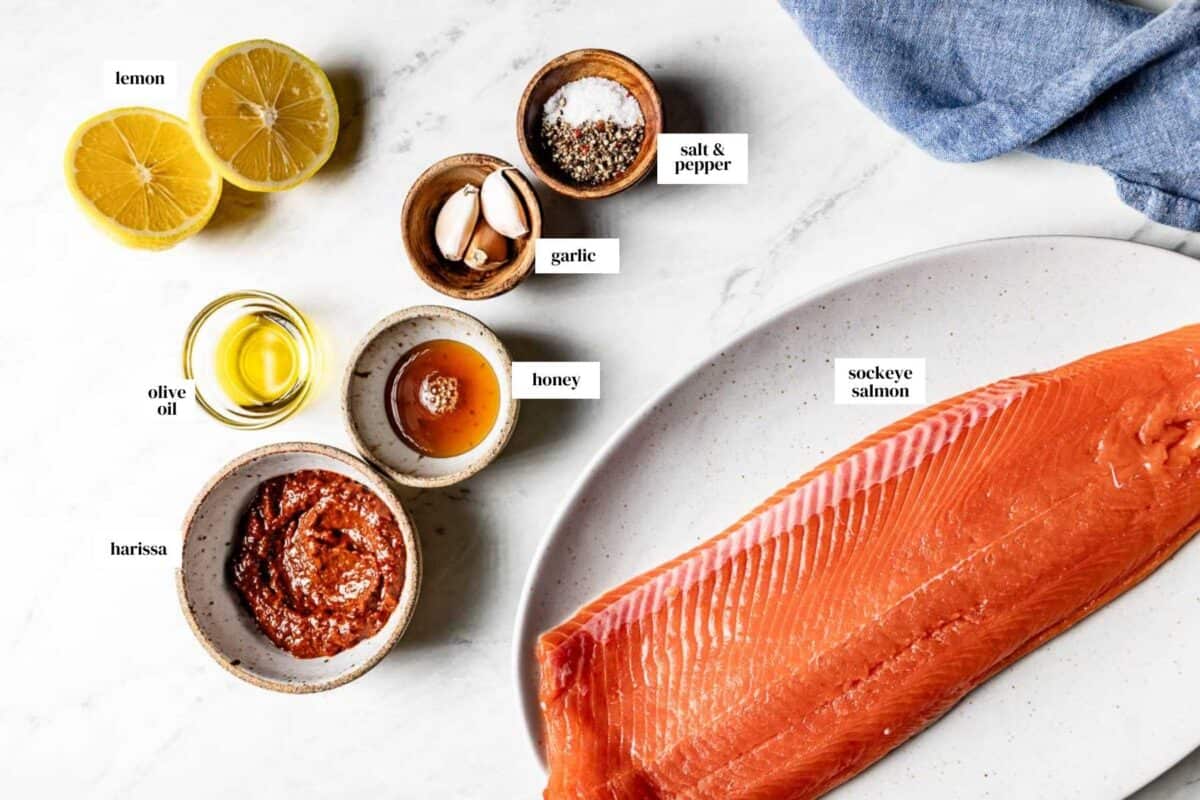
You’ll find the full list in the recipe card below, but here are my notes on the key ingredients and why they make such a difference:
Harissa: Thanks to social media, harissa, a spicy and smooth chili sauce originating in Tunisia, is having a moment right now. And I have to say, it is for a good reason because it is delicious.
As a little trivia, most versions of harissa you find at markets are the Moroccan version of this North African sauce, mixed in with other ingredients such as red peppers, preserved lemons, etc., compared to the original recipe made with dried chili peppers, olive oil, garlic, and spices.
Regardless of the version of harissa you use, in my opinion, it is the perfect spicy sauce for salmon.
And, when it comes to harissa for this spicy baked salmon recipe, you have a few options:
- Homemade from scratch: You can follow my Harissa Sauce recipe for a homemade version, which takes about 45 minutes to make (with just 10 minutes of hands-on time).
- Homemade from harissa powder: You can also make your own harissa spice blend (or buy it at the store) and turn that powder into a paste.
- Store-bought: Or, you can buy a jar at grocery stores like Trader Joe’s and Whole Foods, in their “international,” “Mediterranean,” or “ethnic” sections. I tested this recipe with both NY Shuk and Mina, and while they both worked well, my husband and I thought NY Shuk’s preserved lemon harissa had a superior taste.
Still, regardless of the brand, keep in mind that spice levels vary, so give it a taste first and adjust the amount, especially if you’re serving kids.
I’ve tested this recipe with both store-bought and homemade harissa, and while both work, if you have the time, I recommend making your own. It not only tastes better but also allows you to control the spice level.
Salmon: I like to use fresh wild salmon, especially Sockeye, available May through September. However, while wild-caught is my go-to, farm-raised can also be used.
If you can’t get your hands on fresh salmon, you can use frozen salmon, but be sure to thaw it before using.
You can use Atlantic or Pacific salmon, and if you want to treat yourself and don’t mind spending a bit extra, king salmon is an amazing choice. Other options, such as Sockeye and Coho, are also excellent.
You can cook a whole fillet or use pre-cut portions, just aim for center-cut pieces so they are an even thickness and cook at the same rate. Remember that thickness can vary, so you may need to adjust the cooking time.
Finally, you can use skin-on or skinless salmon; it is totally a personal preference.
Honey: Honey is my secret ingredient here, so don’t skip it. Just a tablespoon of it helps balance the heat coming from harissa, the fattiness from salmon, and the acid from lemon slices.
And in case you are wondering, it doesn’t make the whole dish sweet. Rather, it is there to tame the spiciness and offer a surprising sweet pop of flavor.
Olive oil: As it is with any recipe that uses just a few basic ingredients, using a good quality extra virgin olive oil is highly recommended in this baked salmon recipe. Choose one that you like the taste of.
Lately, my go-to has been Garcia de la Cruz, but feel free to use any extra virgin olive oil you enjoy.
Lemon: We use a small amount of lemon juice in this spiced salmon to brighten up the harissa and lemon slices to garnish on top as it is baking in the oven.
You can use lime instead, but keep in mind that the finished dish will have a slightly more tangy and aromatic flavor.
Garlic: In my opinion, fresh minced garlic is the best option, but for a milder flavor, you can also use a teaspoon of garlic powder instead.
Spices: I used kosher salt and black pepper, but you can add your favorites like paprika, cumin, coriander, or a pinch of cayenne for extra heat. Though I would refrain from incorporating too many spices, as we want the spicy harissa to shine.
Fresh herbs: I used a small amount of fresh parsley, mostly for color and a pop of freshness. However, other herbs like fresh dill or cilantro can also be used for a slightly different but just as delicious flavor.
How to Make Harissa Salmon: Step-by-Step Instructions
Cooking salmon with a harissa glaze can look quite simple, but a few small details will make sure it turns out tender, flaky, and perfectly balanced between sweet and spicy. Here is how I do it and why each step matters:
Step 1 – Preheat your oven and prep the pan: Set your oven to 375°F and line a baking sheet with parchment paper to make cleanup easier and prevent the glaze from sticking or burning. This temperature is ideal for salmon because it cooks the fish through but without drying it out in only 12-14 minutes.
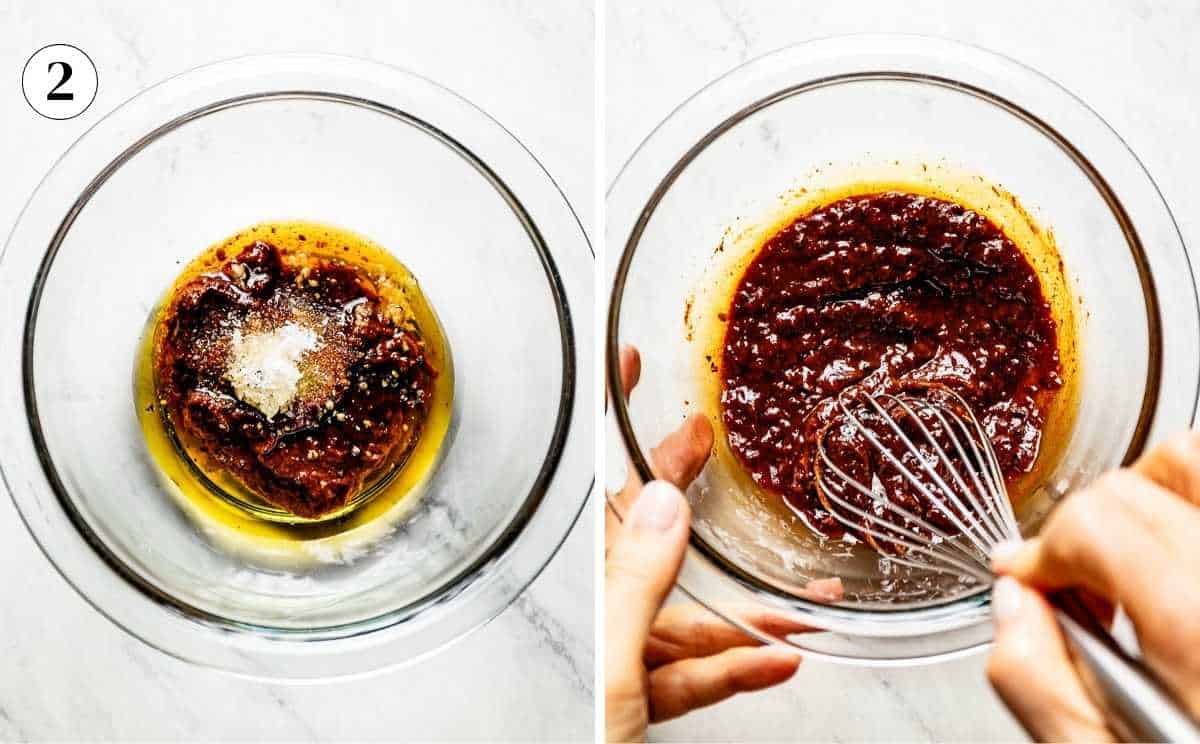
Step 2 – Make the glaze: In a small bowl, whisk together the harissa, honey, olive oil, lemon juice, minced garlic, salt, and pepper. I like to mix the liquids first, then add the seasonings so the honey blends in smoothly. The smoother the glaze, the more evenly it will spread over the salmon, giving you a seasoned bite each time.
Be sure to give it a taste and adjust as needed. If your harissa is very spicy, feel free to add a small amount of honey or lemon juice to balance the heat and adjust the seasoning as needed.
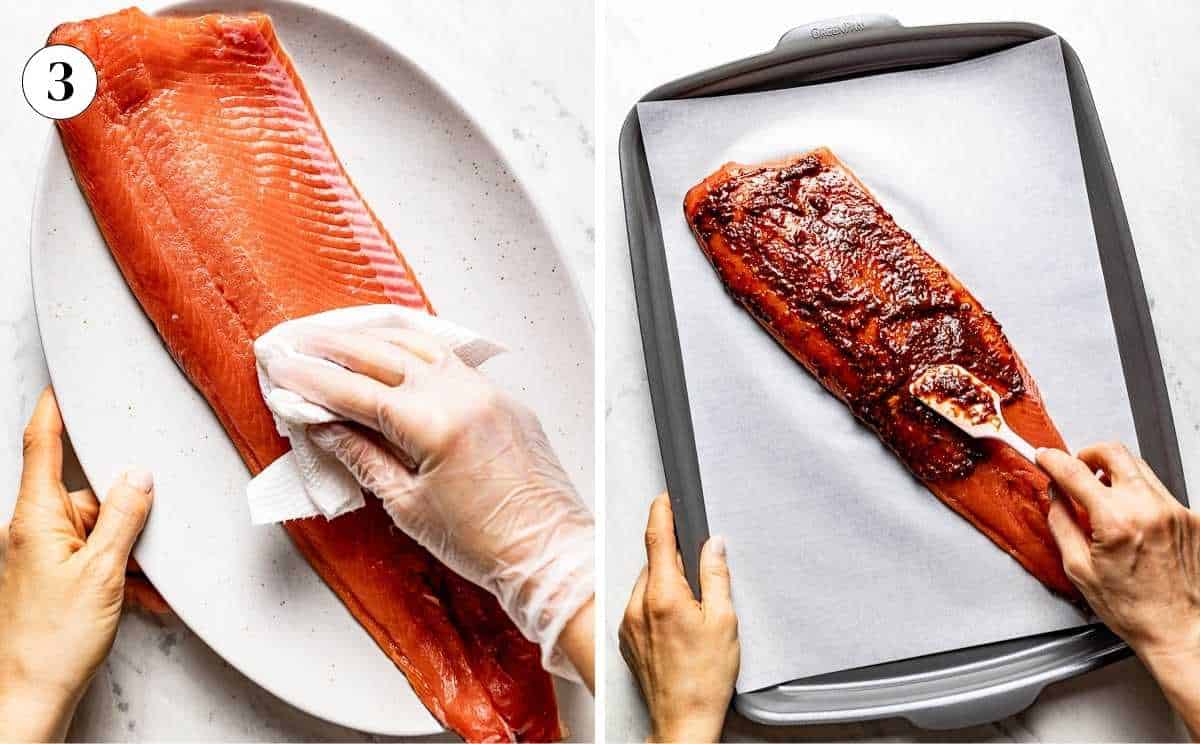
Step 3 – Prep the salmon: Pat the salmon dry on both sides with paper towels to remove that extra moisture. This is an important step in that it helps the glaze stick well on the fish and allows it to roast rather than steam, resulting in a nice, lightly crisp salmon.
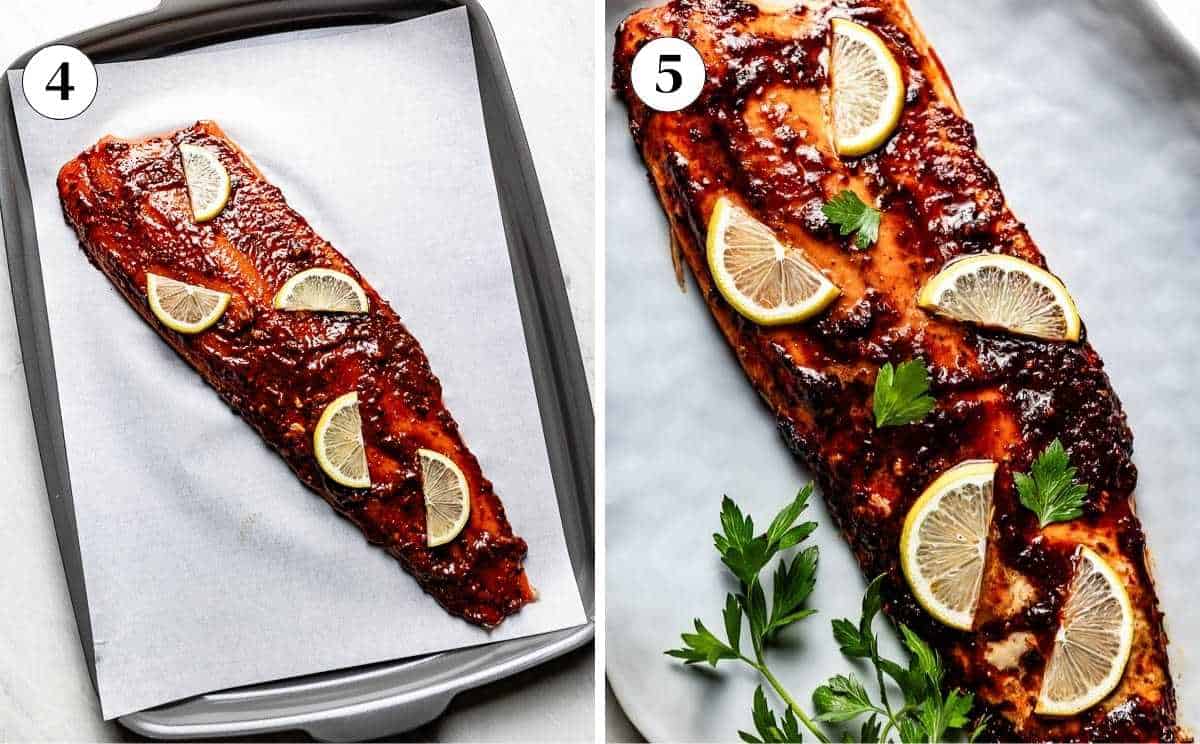
Step 4 – Glaze generously: Next, place the salmon on the baking sheet and spread the harissa mixture over the top, making sure to get the sides too. You want it fully coated so every bite is seasoned.
I like to finish with a few lemon slices on top before baking, because as they cook, they release a bit of juice that soaks into the glaze. This adds a pop of brightness that balances the harissa and makes it visually appealing.
Step 5 – Bake: Place your salmon in the oven and let it bake for about 12 to 14 minutes. You will know it is ready when the thickest, center part of the fillet is between 125 and 135°F on an instant-read thermometer. Be sure to check in the middle and not the thinner ends, since those cook faster and can give you a misleading reading.
We are keeping the temperature gentle and the cook time short because the goal is soft, moist salmon that flakes apart with just a fork. Overcooking can dry it out quickly, so keep an eye on the clock. With that being said, if you prefer a more well-done fillet, bake for about 15-17 minutes.
Step 6 – Garnish and serve: When the salmon comes out of the oven, top it with fresh parsley for freshness. I also like to put extra lemon wedges on the table so everyone can squeeze fresh lemon juice over the salmon.
Expert Tips
Even though this harissa salmon recipe is quick to put together, a few small details can make a big difference in how juicy and perfectly cooked your fish turns out. Here are my notes from years of cooking salmon and testing this recipe:
Remove salmon and harissa from the fridge before use: Remove the salmon from the fridge and let it sit at room temperature for about 10 minutes before cooking. Starting with cold salmon can cause it to cook unevenly. This also applies to harissa, especially if you are using a store-bought brand. It spreads more easily when it is at room temperature.
No need to cover with foil: Some recipes suggest covering the salmon with foil, but since this one cooks quickly, leaving it uncovered helps the glaze caramelize while still keeping the salmon tender.
Use a meat thermometer: This is the best way to avoid dry salmon. Aim for 125 to 135°F in the thickest, middle part of the fillet. If you are using a different type of salmon, you may need to adjust the cooking time depending on its thickness.
If you don’t have a thermometer, you can gently peek in the middle with a fork. It should flake easily and look cooked through, not raw or pinkish.
Don’t overcook: Salmon cooks pretty quickly, and overcooking is the fastest way to dry it out. By using a gentle oven temperature and baking it just long enough, you end up with soft, flaky fish that comes apart easily with a fork and stays nice and juicy.
Coat all sides with the glaze: Take a minute to make sure to cover every bit of the salmon with the harissa and honey mixture, not just the top. As it bakes, the mixture caramelizes, and with the roasted lemon on top, it’s absolutely delicious.
What To Serve With This Spicy Salmon Recipe?
One of my favorite things about this spicy baked salmon recipe is how easy it is to turn it into a complete meal. You can keep it light with a fresh salad, add something hearty like a grain, or drizzle it with a creamy sauce. Here are a few ideas:
Grains: Light, citrusy grains go so well with the heat from the harissa. My Lemon Orzo or Lemon Quinoa add a nice freshness and are great for soaking up that extra glaze.
Salads: If you are looking to keep the Mediterranean-theme going, pair it with either my Mediterranean Pasta Salad or Quinoa Tabbouleh. If you want something cooling to balance the spice, my Creamy Cucumber Salad is always a hit.
Sauce: A drizzle of Yogurt Dill Sauce on top or on the side is the easiest way to add creaminess and a fresh, herby touch that works perfectly with the spicy-sweet salmon.
How To Store and Reheat?
If you have leftovers, you can definitely enjoy this salmon the next day. It’s great cold over a salad, or you can gently reheat it so it stays moist.
Storage: Once the salmon has cooled, store it in an airtight container in the fridge for up to 2 days. If possible, keep it whole instead of flaking it apart, as this helps it retain more moisture when reheated.
Reheating: Salmon dries out quickly, so it is best to reheat it low and slow. Here, you have two options:
- In the oven: Pop it in a low heat oven (275 °F / 135 °C) for about 7-10 minutes or until heated thoroughly.
- In a skillet: Place the salmon in a non-stick skillet over low heat with a splash of water to create a little steam to keep the fish moist as it reheats. Keep a close eye on it as it warms very quickly.
Make Ahead: This recipe comes together so quickly that I wouldn’t bother making it ahead. You’ll get the best texture and flavor when it’s fresh from the oven.
Freezing: I don’t recommend freezing cooked harissa salmon. The texture of the fish changes, and it loses that soft, flaky quality we love.

Harissa Salmon Recipe
Ingredients
- 3 tablespoons harissa, homemade or store-bought
- 1 tablespoon honey
- 1 tablespoon olive oil
- 1 tablespoon lemon juice , or lime juice
- 1 garlic clove, minced
- ½ teaspoon kosher salt
- ¼ teaspoon ground black pepper
- 1 ½ lbs salmon filet, skin on or off*
- 1 lemon, sliced
- Fresh parsley leaves, for garnish
Instructions
- Preheat your oven to 375 °F (191 °C). Line a baking sheet with parchment paper and set it aside.
- Into a bowl, place harissa, honey, olive oil, lemon juice, minced garlic, salt, and black pepper. Whisk until fully combined. Taste for seasoning and add more if necessary. Set it aside.
- Pat-dry the salmon on both sides using a few sheets of parchment paper. Transfer it to the prepared baking sheet.
- Spread the harissa mixture evenly on the salmon, ensuring that all the top and sides are fully covered. There is no need to spread harissa at the bottom. Top it off with a few slices of lemon.
- Bake in the preheated oven for 12-14 minutes or until your salmon registers between 125 to 135 °F.
- Garnish with parsley and serve it with lemon slices/wedges on the side.
Notes
- Salmon: I prefer using wild Alaskan salmon (such as Sockeye Salmon or King Salmon) in most of my salmon recipes, and this one is no exception. However, you can use any salmon you can get your hands on. If it is thawed, be sure to fully thaw it before spreading it with harissa. Also, keep in mind that the baking time could change based on the thickness of your salmon.
- A Whole filet or slices? Both would work. I usually shop for salmon in Costco, and they sell it as a filet. However, sliced salmon can also be used.
- Skin on or off: Both would work.
- Storage: While this dish tastes best fresh out of the oven leftovers can be kept in an airtight container in the fridge for up to 2 days.
Nutrition
Nutrition information is automatically calculated, so should only be used as an approximation.
FAQs
In a pinch, you can use Turkish red pepper paste (biber salcasi) or even sriracha. Just know they are not quite the same. Sriracha is tangier and sweeter, while harissa has a deeper, spicier kick that is fantastic in marinades, dips, soups, and roasted meats. If you swap, the overall flavor will be a little different, but still delicious.
If you have a meat thermometer, aim for 125 to 135°F in the thickest, middle section of the fish. If you do not have one, use a fork to gently peek inside. The salmon should flake easily and look opaque, not raw or too pink in the center.
The spice levels depend on the harissa you are using. If you are making it home, you can adjust the spice levels by removing most of the seeds from the chilies. If you are buying harissa from the store, choose a brand that suits your taste and spiciness preference.
You sure can. I usually use my Grilled Salmon Recipe as a guide when grilling. Simply preheat your grill to 350 °F/177 °C. Place salmon, skin side down, and cook uncovered for 3 minutes or until it releases easily. Carefully flip and cook the other side for another 3 minutes or until the thickest part of it registers 125 °F to 135 °C.
You sure can, but be sure to thaw your salmon fully before using it in the recipe.
Yes, you can. For best results, use 2-3 salmon fillets instead of a whole side of salmon. Preheat your air fryer to 400°F and cook the fillets for about 5 minutes. Then, carefully spread the salmon with harissa paste over the top and continue cooking for another 2-3 minutes, or until the salmon is cooked through and flakes easily. Just keep in mind that cooking time may vary depending on the thickness of your fish.
Other Harissa Recipes You Might Like:
If you love harissa and are in need of more creative ideas to use it, these recipes are worth a try:
- My Harissa Vinaigrette is a quick CAVA-inspired dressing that you can drizzle over salads, grain bowls, grilled meats, or roasted veggies.
- For a simple weeknight dinner, Grilled Harissa Chicken pairs tender chicken with the bold, smoky kick of harissa and comes together with just 20 minutes of hands-on time.
- When you’re craving a sweet-and-spicy combo (similar to this harissa honey salmon recipe), my Harissa Honey Chicken combines harissa with honey, garlic, and lemon for roasted caramelized chicken thighs.
This post may contain affiliate links. If you purchase through these links, I may earn a small commission, at no additional cost to you.


